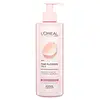What's inside
What's inside
 Key Ingredients
Key Ingredients

 Benefits
Benefits

 Concerns
Concerns

 Ingredients Side-by-side
Ingredients Side-by-side

Rosin
Water
Skin ConditioningParaffinum Liquidum
EmollientIsopropyl Myristate
EmollientPropylene Glycol
HumectantZea Mays Germ Oil
EmollientJasminum Officinale Extract
MaskingRosa Gallica Flower Extract
AstringentSorbitol
HumectantCarbomer
Emulsion StabilisingTriethanolamine
BufferingLecithin
EmollientDisodium Cocoamphodiacetate
CleansingCarrageenan
Pentylene Glycol
Skin ConditioningPolysorbate 20
EmulsifyingPentaerythrityl Tetra-Di-T-Butyl Hydroxyhydrocinnamate
AntioxidantMethylparaben
PreservativePhenoxyethanol
PreservativeEthylparaben
PreservativeLinalool
PerfumingLimonene
PerfumingCitral
PerfumingParfum
MaskingRosin, Water, Paraffinum Liquidum, Isopropyl Myristate, Propylene Glycol, Zea Mays Germ Oil, Jasminum Officinale Extract, Rosa Gallica Flower Extract, Sorbitol, Carbomer, Triethanolamine, Lecithin, Disodium Cocoamphodiacetate, Carrageenan, Pentylene Glycol, Polysorbate 20, Pentaerythrityl Tetra-Di-T-Butyl Hydroxyhydrocinnamate, Methylparaben, Phenoxyethanol, Ethylparaben, Linalool, Limonene, Citral, Parfum
Water
Skin ConditioningParaffinum Liquidum
EmollientDisodium Cocoamphodiacetate
CleansingVitis Vinifera Seed Oil
EmollientGlycerin
HumectantPropylene Glycol
HumectantGlyceryl Stearate
EmollientCetyl Alcohol
EmollientPEG-100 Stearate
Carbomer
Emulsion StabilisingSodium Hydroxide
BufferingEthylhexylglycerin
Skin ConditioningPhenoxyethanol
PreservativeHydroxyethylcellulose
Emulsion StabilisingBHT
AntioxidantIngredients Explained
These ingredients are found in both products.
Ingredients higher up in an ingredient list are typically present in a larger amount.
Carbomer is a polymer of acrylic acid. Its main role is to create a gel consistency.
A high amount of carbomer can cause pilling or balling up of products. Don't worry, most products contain 1% or less of carbomer.
Disodium Cocoamphodiacetate is a surfactant and helps cleanse skin. It is created from the fatty acids of coconut oil.
Surfactants help rinse oil, dirt, and other pollutants easily from skin. It has a faint fruit-like scent.
Paraffinum Liquidum is also known as liquid paraffin. It is a type of highly refined mineral oil.
Like other oils, Paraffinum Liquidum has emollient properties. Emollients help soothe and soften the skin. By creating a barrier to trap moisture within, emollients help keep your skin hydrated.
Paraffinum Liquidum does not irritate the skin and is non-comedogenic.
Learn more about Paraffinum LiquidumPhenoxyethanol is a preservative that has germicide, antimicrobial, and aromatic properties. Studies show that phenoxyethanol can prevent microbial growth. By itself, it has a scent that is similar to that of a rose.
It's often used in formulations along with Caprylyl Glycol to preserve the shelf life of products.
Propylene Glycol is an odorless, colorless liquid. As a humectant, it helps skin retain moisture. It also aids in delivering active ingredients.
Another role of this ingredient is preventing a product from melting or freezing. Propylene glycol also adds antimicrobrial properties to a product, elongating product lifespan.
This ingredient is considered an organic alcohol and commonly added into both cosmetics and foods.
Those with sensitive skin or conditions may develop a rash when using this ingredient.
Learn more about Propylene GlycolWater. It's the most common cosmetic ingredient of all. You'll usually see it at the top of ingredient lists, meaning that it makes up the largest part of the product.
So why is it so popular? Water most often acts as a solvent - this means that it helps dissolve other ingredients into the formulation.
You'll also recognize water as that liquid we all need to stay alive. If you see this, drink a glass of water. Stay hydrated!
Learn more about Water